![]() September 2002
September 2002
Outdoor Smarts
Bag Yourself a Good Night's Sleep
By Karen Berger
Photographs By John R. Fulton Jr.
If you want nights of dream-filled slumber out on the trail, be sure to consider these five key points when deciding which sleeping bag is right for you.
At the end of a day of hiking, you've earned your sleep—and you need it! For the next 8 to 10 hours, your sleeping bag will be your most important (or at least, most appreciated) piece of gear.
But with hundreds to choose from, how do you pick the sleeping bag that's right for you? Here are five things you should know before you buy one.
1. Pick your temperature
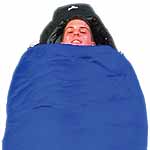 EMS Cold Snap Down 20 degrees |
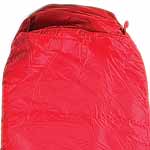 Slumberjack Tour Lite Thermolite Extreme 40 degrees |
Sleeping bags are rated according to temperature. In theory, a 20-degree bag will keep you warm in 20-degree temperatures; a 40-degree bag will keep you warm in 40-degree temperatures, and so on.
Unfortunately, it's rarely that simple. A 20-degree bag from one manufacturer might not be as warm as a 20-degree bag from another. The easiest way to compare bags: Fluff them up and set them on the floor next to each other. The fluffiest bag is usually the warmest.
People's body temperatures are also different, and you may sleep warmer (or colder) than other people. If you're the type who always needs extra blankets, then you need a warmer bag.
To pick the right bag, try to imagine the lowest temperature you'll be camping in, then pick a bag rated 5 to 10 degrees colder. But don't go overboard: "Warmer" is not necessarily "better." In summer, a bag that is too warm is uncomfortable—plus it weighs more and costs more.
Here are some guidelines: Most summer hikers will be comfortable in a 40-degree bag. Those who hike above treeline or in the spring and fall usually use 20- to 30-degree bags. Most winter wanderers need a bag that can handle 0- to 20-degree temperatures.
2. The stuff inside
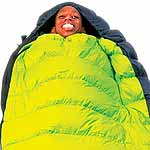 Kelty Light Year Down 45 degrees |
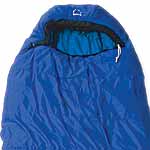 Sierra Designs Clark Polarguard 3D 35 degrees |
The next consideration is fill (the insulation). Many campers prefer down, but in recent years, technology has narrowed the weight vs. warmth gap between down and synthetics. You can find appropriate bags made of either down or synthetics for almost any temperature range.
Down insulates better than synthetics, and it is highly compressible, so it takes up less space in your pack. But all down is not created equal.
Down fill is measured in numbers usually ranging from 550 to 850. In simple terms, "fill" is a measure of fluffiness (more technically speaking, how much "loft" the down has). The loftier the down, the warmer it keeps you—and the higher the price.
Down's major flaw is that it loses almost all of its insulating capacity if it gets wet, and a wet down sleeping bag is useless. As a result, you need to protect a down bag by carrying it in a waterproof stuff sack or use a synthetic bag.
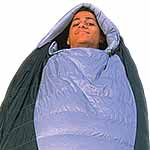 Marmot Never Winter Down 30 degrees |
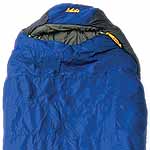 REI Polar Pod Polyester 20 degrees |
3. Size and shape
The fit of your sleeping bag is not as important as the fit of your boots, but it makes a difference in how comfortably—and warmly—you sleep.
Mummy bags are the snuggest and warmest. Semirectangular bags offer a little more room for claustrophobic sleepers. Rectangular bags are the roomiest—also the draftiest.
Other variations of bags include width, length, and even gender. (Men's bags are longer, with more room in the shoulders. Women's bags are shorter, with more room in the hips.)
What's the best way to find one that fits? Climb into it in the store! The bag should fit loosely enough to allow you to wear a few layers of clothes when the temperature gets colder than you expected. You should also be able to move around in the bag and reach all the zippers and cords.
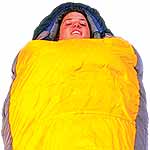 L.L. Bean Summit 3D Polarguard 3D 20 degrees |
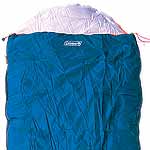 BSA Supply/Coleman Acadia Hollofil 808 25 degrees |
4. Shell material
A sleeping bag's shell material probably won't be a deciding factor in your purchase. But if you plan to spend the bulk of your hiking time in a desert, look for breathable, lightweight fabrics like taffeta and ripstop nylon. If you're headed for a rainforest, choose from among the many breathable, water-resistant fabrics available.
In between those extremes, you'll find fabrics like microfiber, tightly woven nylon, or polyester, which is somewhat water-resistant and will protect the insulation from leaks, condensation, and contact with wet gear.
5. Other considerations
Three-season bags should have a hood. For colder weather, you need a draft collar (to hold in air around the neck) and a draft tube that runs the length of the bag (to protect the zipper from leaking cold air).
Some bags, such as those manufactured by Big Agnes, have a fabric sleeve in back through which you can place your sleeping pad. This holds the bag securely on top of the pad: No more tossing and turning until you slip off the pad and onto the hard ground.
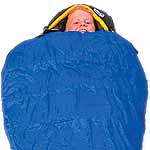 The North Face Cat's Meow Polarguard Delta 20 degrees |
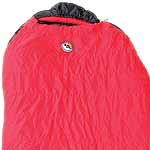 Big Agnes Encampment Polarguard 3D 15 degrees |
Care and cleaning
Care instructions vary according to the type of fill and the manufacturer.
Some bags should either be hand-washed or washed on the gentlest cycle in a front-loading machine (the agitator motion in most washing machines can easily rip the baffles inside of your sleeping bag), then air-dried (again, on the gentle cycle). Check with your manufacturer for specific instructions. Some manufacturers also offer a cleaning service.
Store your sleeping bag outside its stuff sack: Compression will damage down over time. With care, your bag may keep you snug for many years.
Karen Berger is the author of eight books. Her most recent is Hiking the Triple Crown (Mountaineers Books, 2001). Check out her adventures at her new Web site at www.hikerwriter.com..
COMPARING RATINGS, FEATURES, AND PRICESBuying a sleeping bag is a personal decision based on the conditions in which you plan to hike, your body's natural ability to stay warm, and the supplemental gear you use. It's much more important to choose a bag by its features than by manufacturer. Store brands sold by outdoor specialist companies like the BSA Supply Division, REI, EMS, and L.L. Bean offer good value. The chart below shows some of the many options, variations, and price ranges available.
|
September 2002 Table of Contents
Copyright © 2002 by the Boy Scouts of America. All rights thereunder reserved; anything appearing in Scouting magazine or on its Web site may not be reprinted either wholly or in part without written permission. Because of freedom given authors, opinions may not reflect official concurrence.
| The Boy Scouts of America | http://www.scouting.org |